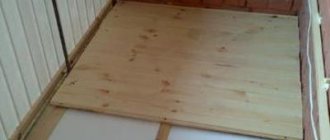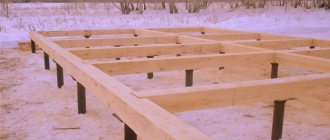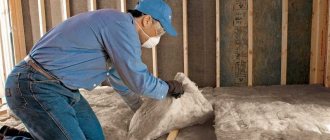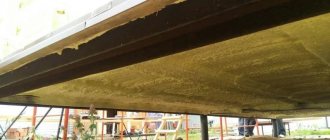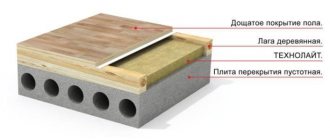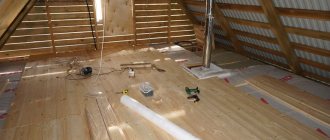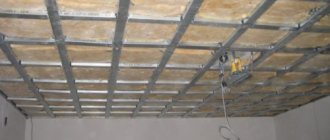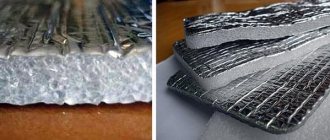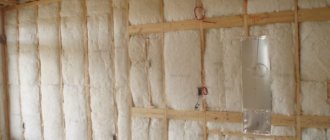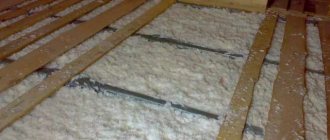The problem of maintaining heat in a house can be solved by laying traditional thermal insulation, for example, mineral wool, expanded polystyrene or foam. They have excellent insulating characteristics, but at the same time they have to put up with serious disadvantages, such as heavy dusting and the release of unsafe styrene or toluene vapors. As an option, you can insulate the floor with isolon; the material is quite new, but has already proven itself as a leader, without bad habits.
Izolon can be laid on both wooden and concrete floors
Types of isolon for thermal insulation of floors
There is nothing new in the technology of insulation with isolon. The material has been produced for quite a long time, so insulating the floor in a private house with isolon could have been done a decade and a half ago. Another thing is that insulation was used on a large scale mainly in industrial equipment, and only recently attracted everyone’s attention with its rather interesting characteristics.
The material is polyolefin foam with an additional reflective coating of aluminum foil. Due to this, it is easily recognizable by its characteristic surface pattern.
In order to get the desired effect from the installed thermal insulation, you need to imagine what kind of isolon structure is suitable for the floor in a wooden house as insulation.
The industry produces isolon with different structures:
- The classic version of foamed polyethylene filled with a pore-forming gas agent, this includes Izolon 100 and its foreign analogues;
- Foamed polyethylene, reinforced with catalyst additive. As a result, chemical bonds appear between individual pores—cells—that improve the durability and strength of the insulation. A typical representative is Izolon 300;
- Heavy and dense PET, which has undergone special treatment by sintering at elevated temperatures and irradiation. As a result, cells are crosslinked at the physical level, without the participation of reagents. The most striking representative of this type is Izolon 500.
Important! The greater the depth of additional processing of polyethylene foam, the higher its strength, the greater the number of air cells, and, accordingly, the lower the thermal conductivity coefficient.
Brands with a soft and viscous structure perfectly absorb noise and vibrations; Izolon 100 is suitable for soundproofing the floors and walls of a building. The more internal connections between the cells, the harder the material is, and the worse the sound insulation of the floor based on isolon works.
Izolon 300
In addition, thermal insulation based on foamed polyethylene is available with one-sided foil, with double-sided foil and also with a self-adhesive base on one side.
Izolon 300
This type of thermal insulation can be considered as a universal material, equally suitable for noise control and floor insulation. The three hundredth Izolon has good noise-absorbing characteristics, within 22-25 dB. The material is able to withstand prolonged heating and constant alternating load.
Laying isolon 300 on the floor guarantees effective protection against any vibrational low- and high-frequency noise and sounds. Isolon is especially good as insulation and sound insulation on concrete floor slabs. Available in rolls, in the form of a sheet with a thickness of 5 to 10 mm.
Material marking uses a numerical index, a sequence of four digits. The first two indicate the foaming ratio of the material, usually it is 30, which means an increase in the volume of polyethylene during processing by 30 times. The second pair of numbers indicates the thickness in millimeters.
Important! A good argument for using Izolon 300 as floor insulation in a wooden house is the fact that three hundredth polyethylene foam is the main material for heat and sound insulation of modern car bodies.
The cost of insulation directly depends on its thickness, on average the price is 1-3 dollars per meter.
Izolon 500
One of the most common and widely used insulation options for walls and floors of wooden houses, stone and brick buildings. In a situation where complete floor insulation is required, “Izolon 500” is subjected to special thermal and radiation treatment, as a result of which the insulation surface is quite rigid and durable.
Material characteristics:
- The compressive strength is 0.036 MPa, which means that you can walk on the insulation laid on the floor as if you were walking on EPS. Unlike penoplex, isolon retains fairly high elasticity and the ability to stretch without destruction by 130-180%;
- The thermal conductivity coefficient is only slightly higher than expanded polystyrene and mineral wool. It is 0.031 W/m*K versus 0.028 W/m*K for competitors;
- Izolon's flammability class is at the G2-G4 level.
Izolon 500 is somewhat inferior in noise insulation and sound absorption efficiency to its closest relatives. This figure is 20 dB versus 22 dB for the 300th brand and 26 dB for the 100th.
For wooden floors, insulation with a self-adhesive layer is best suited
The material is produced in the form of sheets with a thickness of 20 mm to 100 mm. Polyethylene foam can be easily cut and cut into any configuration for installation both on the screed and between load-bearing floor joists. The cost of Izolon 500 is 40% higher than that of the three hundredth brand.
The presence of full aluminum foil instead of a metallized lavsan coating, like penofol or polyisol, guarantees high thermal resistance when heated and at the same time provides almost complete, at the level of 97%, reflection of radiant heat.
What to choose for a specific situation
There is no universal recipe for using isolon. For example, for laminate flooring, it is recommended to use a 25 mm thick sheet for insulation and sound insulation. If the room is heated with infrared heaters, then insulation with a foil screen can be installed.
For interfloor ceilings, especially in modern houses where the floors are made of concrete slabs, it is recommended to use dense isolon 500 with a thickness of 8-10 mm. If you plan to install a heated floor in the room, then it is best to use double-sided foil-coated insulation material up to 10 mm thick.
Isolon may be inferior to mineral wool in terms of insulation efficiency, but there will definitely be no problems with it due to water, condensation or pathogenic microflora
A similar material can be used under classic concrete pouring or in a dry backfill screed. For insulation along joists or in two-layer versions using mineral wool, Izolon with a thickness of 20 mm and above is used.
Izolon - what is it ↑
This material is an elastic polyethylene foam with a closed-cell structure. In addition to the fact that isolon is hygienically and environmentally safe, it has an extensive range of insulating characteristics. Thanks to its cellular structure, foamed polyethylene practically does not absorb liquid and moisture, and also has a high level of heat and sound insulation.
For your information. Most often, foil-coated isolon is used for the home, which has a thin metallized coating on one or both sides. The use of foil significantly increases thermal insulation, which is due to the reflective properties of the material.
Depending on the production technology, folgoizol is available in two types:
- cross-linked polyethylene foam (PPE);
- non-crosslinked polyethylene foam (NPE).
In the first option, polyethylene molecules are cross-linked together, thereby increasing the thermal insulation properties and achieving a longer service life. This process can be carried out both chemically and physically, each of which allows one to obtain the required parameters.
Non-crosslinked isolon has fewer chemical bonds, and therefore is inferior in characteristics to PPE. However, given the relatively simple production, its price is more attractive to the consumer.
Which side should I place the isolon on the floor?
Experts advise in any case to carry out insulation with the foil surface directed towards the inside of the room. In this way, it is possible to block the leakage of radiant heat and at the same time strengthen the vapor barrier of the floor.
An exception may be a scheme with two-layer insulation of plank floors on wooden logs, provided that water heating is used in the house. For example, when laying the bottom layer of mineral wool, you can lay foil-coated polyethylene foam with aluminum foil to the mineral wool. This is done in order to block the seepage of supercooled water vapor through the layer of polyethylene foam insulation. The foil perfectly traps vapors, prevents moisture from condensing and forces it to escape through the air gap between the isolon and the mineral wool.
Characteristics and advantages of isolon
The material has the following properties:
- High reflectivity. Thanks to this, heat loss in the room is significantly reduced.
- Moisture-proof. The insulation does not absorb moisture at all, which ensures its long-term operation without loss of heat-insulating properties. This characteristic is especially important when laying in wooden houses.
- It has a small thickness - from 2 to 15 mm, and does not bear additional load on the structural elements of the log house. Excellent for floor insulation in rooms with low ceilings, saving usable room space. Despite its small thickness, its thermal insulation qualities are comparable to those of a brick wall.
- Environmental Safety. The material does not contain or emit harmful components, making it completely harmless to humans and can be used in any room.
- It has a long service life and retains its properties at temperatures from -80 to +120 degrees.
- Resistant to biological factors, not subject to decomposition and rotting.
- Has good soundproofing characteristics.
The material is produced in the form of rolls or sheets of standard sizes.
For those who are interested in whether it is possible to insulate a floor with isolon, you need to give a definite answer: “Yes,” since the material combines perfectly with wood and is the best choice for thermal insulation of floors in houses made of logs and timber. Izolon is also excellent for insulating ceilings, walls and other structural elements from inside the house.
How to attach isolon to the floor
It is clear that the method of fixing the insulation depends on the nature of the base. Foamed polyethylene, even with great thickness, remains a plastic material. Therefore, it is impossible to lay Izolon on the floor using point fastening with self-tapping screws or metal brackets. Under load, isolon can break at the fastening points.
It is best to lay the insulation on an adhesive basis, and the glue should not dry out. These can be viscous oil mixtures, silicones, but it is best to use self-adhesive polyethylene foam or double-sided construction tape with a metallized surface.
Types of foil insulation
Traditionally, isolon is sold in the form of rolls, but the thickest types of insulation (usually 15 mm) can also be produced in the form of sheets of a standardized size.
Polyethylene foam insulation comes in three main varieties:
- with one-sided foil;
- with double-sided foil. Such insulation materials are used when it is necessary to further enhance the thermal insulation properties;
- with foil on one side and a self-adhesive layer on the other side. The adhesive base is covered with a protective film. Typically, this material is used to insulate various types of vertical and inclined surfaces. Thanks to the self-adhesive layer, the process of performing thermal insulation work becomes as convenient and fast as possible.
Also, the insulation materials under consideration are classified depending on the properties of the source material. Thus, budget varieties are most often produced on the basis of ordinary polyethylene. The material is foamed repeatedly during production. As a result, a closed porous gas-filled structure is created. Such insulation has 2 main disadvantages: a tendency to shrink and low resistance to deformation loads.
More attractive in terms of performance characteristics is thermal insulation material made from the so-called. "cross-linked" polyethylene. Such insulation has a much higher density, withstands mechanical loads better and tends to restore its original shape after the cessation of dynamic influences.
ISOLONTAPE self-adhesive material coated with glue on one or both sides
How to attach isolon to a wooden floor
A slightly different scheme is used when laying the panel on a wooden base. If you need to insulate a plywood floor, it is best to lay insulation without fixing it to the base. Only the joints between sheets or panels are sealed. This method is recommended for a wooden base under flooring in the form of linoleum or laminate.
When laying isolon on joists, fixation is performed using staples, glue and wooden slats.
Types and characteristics of thermal insulation Izolon
Foamed polyethylene Izolon with and without foil.
Izolon is a brand that produces polymer materials for insulation, noise and sound insulation with a closed-cell structure. Product line:
- Isolon 100 – non-crosslinked polyethylene foam;
- Isolon 300 – chemically cross-linked polyethylene foam;
- Isolon 500 – physically cross-linked polyolefin foam;
- adhesive tapes;
- reflective insulation - foil foamed polyethylene or metallized lavsan film.
The scope of application of the material is very wide: from civil engineering to manufacturing. This is facilitated by high performance. Isolon insulation, characteristics:
- density from 25 to 100 kg/m. cube;
- thermal conductivity – 0.037 W/m*C;
- does not allow steam and water to pass through;
- foil materials absorb 97% of IR radiation.
Some items can withstand heating up to 100 degrees without changing their physical and chemical properties. The service life declared by the manufacturer is at least 30 years. All types of polyethylene foam absorb sound and vibration waves well.
The choice of insulation for a ventilation facade depends only on the material from which the walls are built. For wood, materials that allow steam to pass through are used; for concrete, anything is suitable.
You will find information about insulating hives with foam plastic here.
Preparing the base
Unlike penoplex, polystyrene foam and even mineral wool, Izolon is quite sensitive to mechanical load, so the material can only be laid on a flat horizontal surface. Especially if the flooring is supposed to be laminate or, even worse, linoleum. In this case, the height difference in a one-meter area should not exceed 2-3 mm, and in principle there should be no bumps and depressions.
The concrete floor must be cleaned of loose “cakes”, dust and dirt must be removed. We carefully knock down the cones with a hammer and chisel, and clean off the remains with a grinder. Any depressions must be filled and smoothed to floor level. Next, it is advisable to wash the concrete and cover the floor with a primer. Not with paint, not with varnish, but with a primer for concrete.
Important! Additional treatment does not affect the insulation of concrete with isolon, but the concrete surface, even if covered with thermal insulation, will mercilessly collect dust. This is especially true for thin screeds.
When people walk on the floor, the Izospan cloth will work like an air pump, and all the dust will slowly move from the surface to the walls, and then get inside the room through the baseboards.
Completely worn-out floors need to be overhauled before insulation; a new screed may have to be made. It is impossible to lay Izolon on a surface full of cavities and cracks; under load, the glued panel will separate into separate sheets or strips.
If you plan to insulate the floor with isolon in a wooden house, then first you will need to remove the old floor covering, clean or sand off the paint, and treat the wood with a bioprotective solution. The floorboards are wedged together with wooden inserts, but the cracks cannot be completely sealed, otherwise the floor will rot under the insulation. After sanding, they can be selectively blown out with foam.
Plywood floors are prepared in the same way as concrete floors, you just need to additionally check that all the sheets lie on the base without “popping” or “bubbles”. Holes are drilled in problem areas, foam is blown in and immediately loaded with pressure weighing at least 10 kg.
Technology of insulating the ceilings of a wooden house with isolon
The impressive properties of the material in question make it possible to use it in work when insulating the ceiling with isolon in a wooden house. In this case it usually complements mineral wool. The technology for using the material is as follows:
- First, mineral wool is laid between the ceiling joists;
- Then the isolon is attached to the joists using a stapler, glue or dowels, and the material must be positioned so that it is in a slightly tense position;
- A counter batten is made directly over the insulation, which is also attached to the joists;
- At the final stage, a decorative ceiling covering is installed.
The use of isolon as an independent insulation material or in combination with other thermal insulation materials can significantly increase the energy efficiency of a wooden building. In addition, the additional reflective properties of the foil coating make this insulation method even more attractive to private developers. An important argument in favor of the material is its reasonable cost, which is also one of the most important reasons for its popularity.
New technologies for insulating the walls of a private house have led to the emergence of such attractive materials as isolon. Despite the rather short market history in our country, this method of insulation has already managed to gain great popularity. The purpose of this article is to introduce our readers to this high-tech method of insulation.
How to properly lay foil-coated isolon on a concrete floor under linoleum
Oddly enough, many problems arise with the alignment of the panel. Izolon is usually purchased and stored in rolls; when it comes to laying insulation, the sheet unrolled on the floor acquires a wavy surface. You shouldn’t even try to stick such a “wave” evenly; the isolon will need to be laid out on the back side on the floor, slightly stretched and pressed along the edges with a light weight. After a couple of days, the isolon will become almost flat.
Next, we install the insulation according to the following scheme:
- We lay a waterproofing film on the floor. The procedure is mandatory for basement rooms and rooms on the first floor. For apartments, waterproofing on concrete floors can be omitted and replaced with a primer;
- Using a tape measure, measure the distance between the opposite walls of the room and cut off the Izolon strip with a margin of 10-15 mm. Knowing the width of the insulation roll and the dimensions of the room, we cut the required number of strips. Each time before cutting a new panel, we measure the length along the floor from wall to wall;
- We lay insulation on the floor along the starting wall. We are trying to adjust it so that the side edge of the canvas fits as tightly as possible to the wall. We lay the rest on the floor end to end, but without gluing with tape. Typically, one of the Isolon strips will have to be cut to fit into the overall width of the room;
- Place double-sided tape on the floor along the wall and lay the first strip of insulation on it. After leveling, we attach the remaining edges of the panel to the floor in a similar way. We add the remaining strips of Izolon to those already laid and connect them with tape;
- We lay fiberboard sheets on top of the insulation.
Due to the low strength of Izolon, you should not walk on the insulation; even without shoes you can easily damage the material. Therefore, when carrying out insulation work, it is necessary to use several small sheets of fiberboard, on which they move around the room.
Next, we lay the wood-fiber board, and glue the sheets together at the joints with mounting tape. It is impossible to glue fiberboard directly onto Izolon or lay linoleum on insulation without an intermediate layer. If the thermal insulation thickness is more than 8 mm, then plywood will have to be used instead of fiberboard.
Floor insulation in a private house with Izolon. Double floor system
This is the most popular way to insulate a wooden floor. It consists of two layers of plank flooring, between which steam-hydro-insulation and insulation are placed. Pies can be different, for example:
- Rough layer.
- Sand or expanded clay.
- Cardboard.
- The air gap is 3 cm.
- Finishing layer.
Another option (suitable for first floors with an underground floor, where there are no sub-zero temperatures):
- Rough layer.
- Waterproofing.
- Logs between which sheets of mineral wool are inserted.
- Vapor barrier.
- Finishing layer.
Double floor system - device
Rules for making a subfloor layer:
- Select boards thicker than 2 cm and less than 20 cm wide.
- Boards of this layer cannot be nailed directly to the joists.
- First, a sheathing is made (bar thickness 5 x 5 cm), which is attached to the floor base beam (with self-tapping screws).
- Then the boards of the rough layer are nailed to it (they should not reach the joists).
- There are no strict requirements for the quality of boards and their surface. Even small gaps can be allowed, since the layers of insulation compensate for everything.
The subfloor is not visible to the eye, but the entire pie of building materials will be based on it, so it is recommended to thoroughly saturate the wood with an antiseptic so that it is not destroyed by mold and mildew.
Let's look at how to insulate a wooden floor in a private house with polystyrene foam and penoplex.
These are related materials, but penoplex is not as fragile, more compressive strength, and not as fire hazardous as polystyrene foam.
There will be no additional pressure created on the floors, because the materials are very light.
For insulation, slabs are selected that can withstand a pressure of 35 kg/m2.
Whatever material you choose, the installation technology is similar.
When working with polystyrene foam, additional water protection will be provided (foam plastic is approximately 2 times less resistant to moisture than penoplex). The latter can be mounted without it.
Sequence of work:
- The old floor is dismantled, you need to reach the rough layer. If the work is done from scratch, then the subfloor is built.
- Logs are installed. The distance between them is according to the size of the material slabs, for example, 70 cm.
- For foam plastic: a vapor barrier layer is nailed to the base with a stapler. The joints are taped with tape.
- Sheets of insulation are cut, which need to be tightly laid between the joists (penoplex is cut exactly to size, foam can be made 1 mm wider on each side so that it fits flat).
- Waterproofing layer.
- Finishing boards are laid.
Scheme of subfloor arrangement
Does the floor need to be insulated from the basement? A vapor barrier will serve you well if the basement is damp or if groundwater periodically rises. On the side of the house, a layer of waterproofing is needed if the humidity in the room periodically rises (bathroom, kitchen).
The thickness of the foam layer should be calculated based on the outside temperatures, the degree of insulation of the basement, etc. but on average it is customary to make a layer 10 cm thick.
How to lay isolon under OSB, plywood on a wooden floor
Thermal insulation procedures for plank and plywood floors are slightly different; in the first case, you will have to do thorough preparation to avoid damage to wooden parts, joists and supports. Thermal insulation of a plywood floor is somewhat simpler, but this reduces the height of the ceilings of the room.
We insulate the plank floor
The first step is to remove the floorboards. The boards are carefully unfastened, inspected, rejected or repaired.
Floorboards need to be removed
Only the joists will remain on the floor. If the beams are simply laid on a concrete base, then the procedure for laying Izolon is significantly simplified.
You will only need to lay insulation in the space between the beams. If the logs of the plank floor are raised above the ground on supports, then before laying the insulation, the beams will need to be hemmed with a plank on the cranial blocks, otherwise there will be nowhere to put the thermal insulation.
The general insulation scheme is as follows:
- We remove dust and dirt with a vacuum cleaner, treat the beams with an antiseptic impregnating solution and dry for at least two days;
- We cut Izolon sheets individually, according to the measured distance between the beams;
- If there is additional insulation with mineral wool under the Izolon layer, then first we lay a vapor barrier, then mineral wool, and only then sheets of polyethylene foam and always with staggered seams.
Izospan V or Izolon 100, 2-3 mm thick, can be laid on top of the beams. In both cases, the material is secured with a stapler and glued with tape. The thickness of the main insulating layer must be at least 50 mm.
Laying thermal insulation on a plywood base
First of all, you need to lay a beam on the plywood; it will act as a load-bearing frame that absorbs loads and protects the insulation from loads. The bars can be attached to plywood sheets with self-tapping screws using a vapor barrier film or without it, if the wooden base has been pre-treated with varnish.
The next stage is to lay Izolon between the bars. It is best to use sheets 20 mm thick; the thermal insulation is pushed between wooden guides and connected with tape.
A vapor barrier needs to be laid on top of Izolon. This solution reduces moisture absorption and deformation of the timber in the autumn-winter period. You can sew plywood or OSB on top.
How to work correctly with foil insulation using the example of insulating a balcony ↑
To insulate a balcony, it is important to choose a material that will combine low thermal conductivity, high waterproofing properties and low weight. Foil-coated isolon fits these criteria perfectly. However, even in this case, you may encounter certain problems that usually arise with inexperienced craftsmen.
Often, the insufficient effectiveness of balcony insulation is caused by the small thickness of the foil insulation layer. Therefore, for climate areas with low temperatures, experts recommend using isolon in combination with other insulation, such as mineral wool or polystyrene foam.
When working with expanded polystyrene, foil-isolon is glued to both sides of the insulation. The result is a kind of “sandwich” that will serve not only as a heat barrier, but also as a vapor barrier. It is also important to note that all joints are covered with special aluminum tape in order to ensure maximum sealing of the surface.
You should know. To preserve useful space on the balcony, some owners refuse additional insulation. In this case, it is allowed to use foil insulation with a thickness of at least 20 mm.
One of the main misconceptions of many apartment owners is the opinion that after insulation the balcony will always be warm. It is necessary to understand that insulation, be it self-adhesive foil insulation, polystyrene foam or any other material, does not generate heat by itself, but only traps it inside. Therefore, to ensure comfortable conditions in winter, it is necessary to provide an additional heat source, for example, a “warm floor” system.
How to lay Isolon under a floor screed
Very often, tiles, ceramics or any other floor coverings that require a sufficiently strong and rigid supporting surface are laid on an insulated concrete base. Isolon is an excellent type of insulation, but it is not strong enough, so it will need to be hidden under a screed.
Installation of thermal insulation under a concrete screed is carried out in the following way:
- We lay a waterproofing membrane on the subfloor, be sure to overlap the edges onto the walls to a height of at least 20 mm at the level of the final floor covering;
- We glue the joints between individual pieces of waterproofing twice, the first time with tape during installation, the second time with a primer, before laying the Isolon-based insulation;
- We roll out the roll into sheets and immediately lay the insulation on top of the waterproofing. Moreover, we change the laying direction to 90°. The edges of thermal insulation must also be laid on the walls with an allowance;
- Next, we install the reinforcing mesh; it will need to be raised on chips above the surface of the foil Izolon to a height of at least 20 mm;
- We install beacon chips on the insulation and fill the screed with a cement-sand mixture. The thickness of the screed must be at least 40 mm for insulation up to 10 mm thick. With a larger layer of thermal insulation, the layer is increased to 50 mm;
- After 4-5 hours, the chips are pulled out and the holes in the concrete are sealed.
The edge allowance for waterproofing and insulation is trimmed and fixed with a stapler. The gap is filled with foam and carefully trimmed. All that remains is to glue the tiles and nail the baseboards.
Warm floor on isolon, dry-laid under laminate
How is thermal insulation performed with isolon?
Insulation of the floor in a house made of timber can be done in three ways. Below we will look at each option separately.
First way
Extruded polystyrene foam slabs are laid on the leveled ground, and the seams between the sheets are foamed with polyurethane foam.
A concrete screed is placed on top of the insulation. It is necessary that the concrete base is level, without cracks or other defects. If there are cracks, they must be filled with putty and then sanded.
After cleaning the surface from dust, rolls of isolon are placed on it (the protective film must first be removed from the material), which are fixed to the floor with glue or dowels. The sheets are glued together with foil tape.
Second way
The pre-leveled soil is covered with a waterproof membrane, then mineral wool slabs are placed on it. A waterproofing film is also laid on top. The lower hydromembrane protects the insulation from moisture coming from the ground, and the upper one does not allow it to enter the room.
Floor joists are installed on which boards are laid. The floor is insulated on top of them. Isolon is spread over the insulated surface and secured with a stapler or screwdriver. The joints are sealed with tape with a foil layer. Then the floor covering is laid.
Floor insulation along joists:
- Remove old flooring.
- Lay wooden logs on the rough base at a distance of 600-1000 mm from each other. Before laying, beams must undergo antiseptic treatment to prevent rotting.
- Between the lags, boards or plywood sheets are laid on special cranial bars.
- A layer of waterproofing is laid on the prepared wooden base, and then sheets of insulation are laid out so that the upper edge of the material is lower in height than the joist. Izolon itself has vapor barrier properties, so there is no need to lay a vapor barrier film on top.
- A finishing flooring is laid on top of the heat insulator. To arrange it, boards more than 3 cm thick or sheets of plywood are usually used, which are laid in a perpendicular direction to the beams.
- The finishing floor covering is laid on top of the insulated base.
How to put isolon under an electric heated floor
The first thing you will need to do is lay out the base for laying the thermal insulation. The subfloor can be poured in the form of a screed or assembled from a moisture-resistant plasterboard sheet. In any case, the surface should be as smooth and flat as possible.
Installation of isolon is carried out in the following order:
- We treat the base with a primer;
- We lay Izolon 100 without foil on the floor, carefully glue the joints, the edges should be laid on the walls with an allowance of 30 mm;
- The next layer is made of foil Isolon 500, it is best to lay two layers 10 mm thick with seams spaced apart;
- The sheets are laid out on the floor with the foil facing up and also taped with metallized tape;
- Depending on the design of the heated floor, it will be necessary to install fastenings for heating pipes or cables on the insulation surface. In this case, the floor is covered with screed under the tiles.
For wooden floors, before laying the heating elements, support bars are laid, and only after that the cable or plastic pipes for the coolant are installed. All that remains is to connect the heating, check and cover the floor with a tongue and groove board.
Features of use
The use of floor insulation allows you to increase the insulation characteristics of structures without increasing the height and thickness. It can be used as an independent layer or in combination with other types. In each case, it is necessary to consider the feasibility of installation based on the technology objectives. When installed on a wooden floor, a noticeable thermal effect is obtained. The surface heats up quickly, retains energy for a long time, without additional thick layers.
Interfloor ceilings are among the most susceptible to extraneous sounds and cold penetration. The best way to eliminate the shortcomings is insulation with foil Izolon. It reliably protects engineering systems, ventilation, pipes and gas pipelines. For such work, it is recommended to use a foil stamp. Self-adhesive film is easily placed on a metal surface, holds securely and provides high-quality insulation and insulation from wearer noise. Izolon is suitable for floor insulation during the operation of electrical and water structures. Functions effectively under laminate, parquet, linoleum, and carpet coverings.
The Izolon installation scheme is performed in different ways, depending on the base, and according to the instructions:
1. Insulation for wooden floors.
A concrete screed is made from boards under the structure. Extruded polystyrene foam is placed on a previously cleaned surface, then the solution is poured. The base must not contain cracks or defects. If they form after the mixture has hardened, they must be treated with putty and sanded. After this, the surface is cleaned and the floor is thermally insulated using Izolon. The protective film is removed from the roll, rolled out and fixed with adhesive or fasteners. The joints are sealed with foil tape.
Recommendations and common mistakes
The first mistake appears due to the desire to save. Insulation based on Izolon is quite expensive, so even pieces and small pieces are used. In practice, this means the appearance of a large number of cold bridges at the joints. Pasted tape provides only a mechanical connection; it will not protect against heat loss. Therefore, insulation must be laid with a minimum number of panels.
The second mistake is related to the refusal to use vapor barrier and waterproofing. Membranes must be used without fail; Izolon is capable of absorbing moisture up to 0.01%. This is not much, but it is enough to lead to a sharp increase in the thermal conductivity of the material upon contact with water.
How to insulate a floor with Alufom. Scope of application
Alufom for arranging heated floors
Alufom is used quite widely, today it is used for thermal insulation of various packages, in thermal blankets, in sleeping bags, in tent flooring, in construction, in transport (blinds, awnings), etc., but Alufom is quite widely used used in construction. It is used mainly to reduce heat loss;
Insulating a balcony with Alufoma
- in saunas;
- in country houses;
- walls (outside, inside);
- in agricultural buildings;
- roofs;
- climatic equipment;
- when installing heated floors;
- ventilation;
- boilers, heating devices;
- pipelines;
- metal structures.
Insulation of the engine compartment in a car using Alufoma
In addition, Aluf is used in the transport industry in containers and vans to protect bodies and engine compartments.
Features of application
Since most of the heat loss occurs due to infrared radiation (this is approximately 60-65%), massive thermal insulation materials do not provide good enough protection for the house from heat loss. The main material that can return infrared rays back is aluminum foil. The walls of the building, which have such protection, return heat to the inside of the building in winter, and in the summer heat they reflect thermal radiation outside.
As mentioned above, this is an innovative sound-, hydro-, and heat-insulating material that has a fairly high coefficient of heat reflection. The functionality of Alufom is based mainly on the properties of polished foil with a high aluminum content and the presence of air bubbles in polyethylene microfoam. Such a structure can reflect up to 97 percent of heat radiation in the summer and prevent cooling in the winter.
Aluf is used for pipeline insulation
Advantages
Alufom has many advantages over similar materials. If you look at the reviews, you can use it to create the most reliable and high-quality thermal protection. It also creates hydro-, steam-, and sound insulation and is able to function reliably even in conditions of high humidity. When used, it saves usable space, as it has a small thickness; in addition, during operation it does not wear out, does not rot, and is environmentally friendly. To work with it, you do not need any special clothing; installation of this material is quite simple, since it is light in weight. It has no significant disadvantages.
Alufom on a self-adhesive basis
Types of material
Alufom, depending on the available technical characteristics, can be divided into varieties, such as Alufom A, Alufom B, Alufom S.
- Alufom A is made on a polyethylene base, which is coated with foil on one side. It can be used as a vapor barrier or as an additional layer of thermal insulation, and sometimes it is laid in two layers. In this case, Alufom is able to provide complete warmth and waterproofing.
- Alufom B - made of polyethylene and covered on both sides with foil. It is used for arranging roofs, insulating attics, floors, etc.
- Alufom S (on a self-adhesive base) - polyethylene is covered with foil on one side, and its other side is covered with glue, and on top of the glue with a special coating material. This type of Alufoma is used mainly only on air vents.
